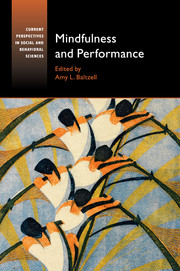Book contents
- Frontmatter
- Dedication
- Epigraph
- Contents
- List of figures
- List of tables
- List of contributors
- Preface
- Acknowledgments
- I INTRODUCTION TO MINDFULNESS: HISTORY AND THEORETICAL UNDERSTANDING
- II FORMAL MINDFULNESS INTERVENTIONS IN SPORT
- III MINDFULNESS: THEORY TO PRACTICE IN SPORT AND EXERCISE
- 10 Mindfulness and the Olympic Athlete – A Personal Journey
- 11 Mindfulness Training Program for Chinese Athletes and Its Effectiveness
- 12 The Mindful AFL Player: Engagement, Mobile Apps, and Well-Being
- 13 Mindfulness and Exercise
- 14 Mindfulness, Eating, Body, and Performance
- IV MINDFULNESS AND THE PERFORMING ARTS
- V MINDFULNESS FOR COACHES, PRACTITIONERS, AND MENTORS
- VI FUTURE DIRECTIONS
- Index
- References
12 - The Mindful AFL Player: Engagement, Mobile Apps, and Well-Being
from III - MINDFULNESS: THEORY TO PRACTICE IN SPORT AND EXERCISE
Published online by Cambridge University Press: 05 January 2016
- Frontmatter
- Dedication
- Epigraph
- Contents
- List of figures
- List of tables
- List of contributors
- Preface
- Acknowledgments
- I INTRODUCTION TO MINDFULNESS: HISTORY AND THEORETICAL UNDERSTANDING
- II FORMAL MINDFULNESS INTERVENTIONS IN SPORT
- III MINDFULNESS: THEORY TO PRACTICE IN SPORT AND EXERCISE
- 10 Mindfulness and the Olympic Athlete – A Personal Journey
- 11 Mindfulness Training Program for Chinese Athletes and Its Effectiveness
- 12 The Mindful AFL Player: Engagement, Mobile Apps, and Well-Being
- 13 Mindfulness and Exercise
- 14 Mindfulness, Eating, Body, and Performance
- IV MINDFULNESS AND THE PERFORMING ARTS
- V MINDFULNESS FOR COACHES, PRACTITIONERS, AND MENTORS
- VI FUTURE DIRECTIONS
- Index
- References
Summary
I was someone who worried a lot about my footy and what everyone thought. I would go home and lie awake at night and having meetings in my head, so now I try to live more day-by-day and be in the present moment.
Brett Kirk, past player and captain, Sydney Swans (Kirk, 2007)This chapter focuses on mindfulness, well-being, engagement, and smartphone applications in the context of the Australian Football League (AFL). It starts with an introduction to AFL, the role of the AFL Players’ Association (AFL Players), and the current state of mind and well-being science in the AFL. We consider mindfulness and well-being research outcomes in nonclinical populations and then explore the use of mobile technology to engage people in the practice of mindfulness. Finally, we describe how AFL Players have approached integrating mindfulness as part of a broader well-being program for players. The mindfulness program implemented at AFL Players was developed by the first author (JM) and informed by the research and applied work of the second author (CH).
The AFL and AFL Players’ Association
AFL refers to the elite Australian Rules football competition known as the Australian Football League. The origins of Australian Rules football can be traced back to 1858, when a game was invented in Melbourne to help cricket players remain fit in the winter months. It is a full-contact, free-flowing, and fast game with players passing the ball by foot and hand, and played on a field the size of a cricket oval (450 to 500 feet in diameter). The AFL was officially formed in 1997 when the Victorian Football League (VFL) expanded to include a number of interstate clubs. Today it is Australia's premier sporting code in terms of participation and viewing (see Appendix A for a more detailed description).
The AFL Players’ Association (originally called the Victorian Football League Players’ Association) was created by the players in 1973 to protect and enhance the collective interests of all football players, current and past. There are approximately more than eight hundred players across the league in a season, and more than five thousand past players. Every current AFL player is a member (plus more than 2,500 alumni members) and contributes to the running of the Association, by paying yearly fees and also by directing a portion of the funding allocation under the Collective Bargaining Agreement to the organization.
- Type
- Chapter
- Information
- Mindfulness and Performance , pp. 268 - 299Publisher: Cambridge University PressPrint publication year: 2016
References
- 1
- Cited by



